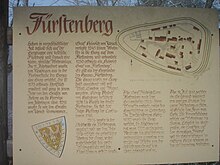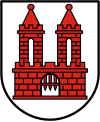Fürstenberg (Huefingen)
|
Furstenberg
City of Hüfingen
|
|
|---|---|
| Coordinates: 47 ° 53 ′ 30 ″ N , 8 ° 33 ′ 8 ″ E | |
| Height : | 790 m |
| Area : | 9.57 km² |
| Residents : | 487 |
| Population density : | 51 inhabitants / km² |
| Incorporation : | 1st December 1971 |
| Postal code : | 78183 |
| Area code : | 0771 |
Fürstenberg is a district of Hüfingen , located to the west below the Fürstenberg mountain . Fürstenberg was originally its own town , which had its origins up on the Fürstenberg at 917 m above sea level near Fürstenberg Castle . This was a castle town and the first seat of the Fürstenberg family . The Celts already had a small fort there . In 1175, the so-called “most vürderste mountain” went to the dukes of Zähringen . Heirs were the Counts of Urach . The Zähringer died out in 1218. At that time there was already a small settlement and a castle. The place still belonged to Neudingen .
13th Century
Between 1218 and 1250 Heinrich von Urach moved his residence here to the Fürstenberg and called himself von Fürstenberg from then on . The Fürstenberg was probably settled from Neudingen and when Fürstenberg was already a town, it still had a market community together with Neudingen. The castle and the city were expanded from then on, it became a larger city. The city of Fürstenberg was surrounded by a rampart and a city wall. King Rudolf von Habsburg confirmed, among others, Count Heinrich von Fürstenberg in 1278 the freedom of Fürstenberg from foreign courts and thus the right to use the title city. A wide market street led from the city gate to the castle. From the north and from the south roads led up the mountain to the city up to the city gate.
From the 16th century
In 1504 a deep well was built in the city to supply the citizens with water. The castle was heavily rebuilt in 1516 and the fortifications renewed. The inhabitants of the city were mostly aristocrats who were employed for the count, for example the lords of Allmandshofen and the lords of Reischach . They provided civil service in the surrounding communities. In addition, soldiers lived on the mountain for defense, a few peasants and servants to provide for them. Nevertheless, Fürstenberg was stormed in the Peasants' War .
In the Thirty Years War , the town and the Fürstenberg castle were largely destroyed, the well was buried, the noble families left the mountain, only a few families in around 50 houses remained. The water was now brought back to the mountain with pack donkeys .
After the major fire on July 18, 1841, the town of Fürstenberg had become uninhabitable. According to tradition, the fire broke out due to a funeral when a spark fell from a censer on a nearby hay cart, according to other sources, the fire was caused by a house fire. One child was killed and 45 houses were burned, including the parish, school and church. The remaining citizens resettled below the mountain in the new town of Fürstenberg, which is basically a village but was given town rights back on April 1, 1956. Most of the ruins on the mountain were used as a quarry for the new city. The newly built church was designated in 1855 and got bells from Constance, which had to be surrendered during the First World War. She received the second from the Grüninger bell foundry ; these had to be given in during World War II. From the home of the parish administrator Franz Simon, from Alt Kemnitz , two still preserved bells came from the Hamburg bell cemetery, to which another new one from Stuttgart was added. In 1951 he also had the oak cross built on the mountain.
On December 1, 1971, Fürstenberg was incorporated into the city of Hüfingen.
coat of arms
| Blazon : "In silver (white) a red pinnacle wall with an open gate, above two pointed red pinnacle towers." | |
| Justification of the coat of arms: The coat of arms awarded on October 8, 1959 commemorates the city charter granted in 1278 by the Counts of Urach-Freiburg . The oldest seal, which is also shown in this illustration, also comes from this time. |
today
On the surface nothing can be seen of the old town of Fürstenberg. One can only guess at the floor plans. In 1971 the town of Fürstenberg was incorporated into the town of Hüfingen. Fürstenberg is currently working on preserving the village character and avoiding bleeding of the place through vacancies, vacant lots and insufficient modernization of buildings with the help of the ELR (rural development) program.
Individual evidence
- ^ Federal Statistical Office (ed.): Historical municipality directory for the Federal Republic of Germany. Name, border and key number changes in municipalities, counties and administrative districts from May 27, 1970 to December 31, 1982 . W. Kohlhammer, Stuttgart / Mainz 1983, ISBN 3-17-003263-1 , p. 494 .
- ↑ Stadler, Klemens, Deutsche Wappen, Volume 8, Bremen 1971, p. 42
literature
- August Vetter: Fürstenberg - The history of the former mountain town in the Baar. 1997.





